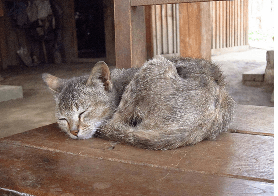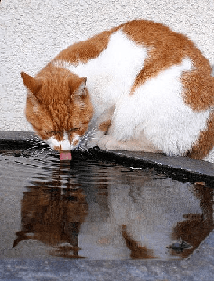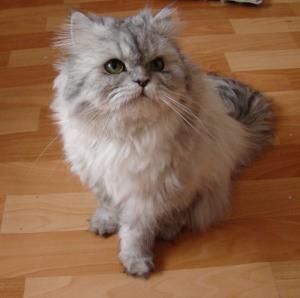What is it?
Hyperthyroidism is a common endocrine condition affecting cats. The condition involves the over-production of hormones from the thyroid, which, in turn, increases the body’s metabolic rate. This has implications for the entire body and prompts a number of changes.
While cats of all ages can develop Hyperthyroidism, it is most prevalent (almost exclusively so), in older animals of 10 years+. Less than 6% of cases occur in younger cats and the average age of onset is 12 years. It is estimated that 5-10% of older cats will develop Hyperthyroidism as they age.
Because the condition increases a cat’s circulating levels of hormone and thus heightens the metabolic rate, left untreated, Hyperthyroidism can make a cat seriously ill and may even lead to heart and kidney failure in some extreme cases. High concentrations of thyroid hormone interact with a number of bodily functions, as well as stimulating the central nervous system (CNS), which may lead to behavioural problems as well as hyperactivity and restlessness.
What are the signs my cat has Hyperthyroidism?
If you suspect Hyperthyroidism, it is probably because you have observed one or more changes in your cat. Clinical signs can be quite dramatic and you may wonder what on earth has happened to your pet in such a short space of time. The most common symptom of Hyperthyroidism is weight loss, which is seen in 95% of affected cats. This often strikes cat owners as strange as most cats will have an increased appetite that is at odds with their continual weight loss. Any weight loss in older cats should be evaluated by a veterinarian as this could be a sign of many serious conditions.
 If your cat does lose weight through Hyperthyroidism, you will probably first notice muscle wastage along the spine. A loss of muscle mass may also be evident on the legs and underside. If the condition is left untreated, your cat may experience severe muscle wasting and emaciation, and this can be fatal. Even if your cat displays no other symptoms, it is very important to explain any weight changes to your vet, especially if your cat appears to be eating more than usual and is still losing weight.
If your cat does lose weight through Hyperthyroidism, you will probably first notice muscle wastage along the spine. A loss of muscle mass may also be evident on the legs and underside. If the condition is left untreated, your cat may experience severe muscle wasting and emaciation, and this can be fatal. Even if your cat displays no other symptoms, it is very important to explain any weight changes to your vet, especially if your cat appears to be eating more than usual and is still losing weight.
Increased appetite is a symptom observed in 65-80% of cats with Hyperthyroidism. Because the condition increases the body’s metabolic rate, affected cats tend to eat more to compensate for this. However, no amount of over-eating can match the body’s weight loss and cats with Hyperthyroidism will continue to lose muscle mass despite their hearty appetites! In rarer cases, some cats will even display reduced appetite, without any of the usual signs of increased activity and restlessness. Instead they may be lethargic and weak and will consume very little. Cats with these symptoms (approx. 5%) have an uncommon type of Hyperthyroidism called ‘apathetic hyperthyroidism.’
Along with increased appetite, most cats with regular Hyperthyroidism will display increased thirst (polydispsia) and will therefore urinate more frequently (polyuria). Cats are notoriously bad at drinking water, which is why they need to get most of their hydration from their food. If you notice your cat is drinking more than usual, don't overlook this important change.
 As mentioned already, high concentrations of circulating hormone can interact with and stimulate the CNS, which commonly causes cats to become hyperactive or intensely nervous. Cats with severe Hyperthyroidism are likely to twitch, tremble and/or have a frantic facial expression. This behaviour tends to intensify at night when affected cats become incredibly anxious and may yowl and pace. Cats with disturbed sleep patterns will sleep more during the day and will be strangely lethargic and drowsy.
As mentioned already, high concentrations of circulating hormone can interact with and stimulate the CNS, which commonly causes cats to become hyperactive or intensely nervous. Cats with severe Hyperthyroidism are likely to twitch, tremble and/or have a frantic facial expression. This behaviour tends to intensify at night when affected cats become incredibly anxious and may yowl and pace. Cats with disturbed sleep patterns will sleep more during the day and will be strangely lethargic and drowsy.
Extreme cases of Hyperthyroidism may prompt heart palpitations and difficulty breathing, with cats at rest panting for no apparent reason. If the condition is advanced, respiratory problems are much more likely and cats will exhibit difficulty and discomfort in breathing even in cool climates. Some cats with Hyperthyroidism will groom themselves excessively, causing baldness and dermatitis. The condition of the coat may also change for the worse, losing its shine and appearance. In cats with advanced Hyperthyroidism, excessive nail growth is another symptom to be aware of. If the nails grow quickly and appear thickened or more fragile, Hyperthyroidism may be the cause.
Lastly, cats with Hyperthyroidism are like to have diarrhoea, loose, or excessive amounts of stools. A third of cats with Hyperthyroidism will frequently defecate and will also urinate more often. This is in keeping with their increased hunger and thirst. Some cats may even vomit after eating (particularly common in cats in multi-cat households) as they rapidly eat to compensate for their heightened metabolism. To help avoid this complication, try to feed your cat smaller amounts more frequently (every 3-4 hours) to prevent your cat from gorging on food until the stomach is uncomfortably full.
Customer case study:
Here, Jeanette Gallie shares her experiences of feline hyperthyroidism and her decision to opt for radioactive iodine treatment.
"Last year, my 12-year old Devon Rex cat started losing weight - she was just skin and bones - yet her appetite had increased. She vomited frequently and pooped at least 4 times a day. Her breathing was also a lot faster. A blood test at my local vets confirmed hyperthyroidism. I had 3 options: 1) Medication 2) Radioactive iodine treatment 3) Prescription diet. Medication and the prescription diet don't cure hyperthyroidism, they only manage it. Radioactive iodine cures it, but the thought of Molly being radioactive scared me, and the side-effects of the medication also worried me, so I chose the Hills Prescription Diet Y/D. I bought both wet and dry food.
It took a week to fully change her to it and by the end of the week, she became really ill. She couldn't keep any of the food down and had to be put on a drip. The vet told us it wasn't looking good for her, but not to give up hope. She was sent home and I took her off the Y/D diet and put some of her usual food in my hand. She could barely lift her head, but she licked some of the food. That was the start of her coming back from the brink. Molly had a check-up again after a few days and the vet said she could refer her to the hyperthyroid cat centre in Wetherby for the radio iodine treatment. It would cost roughly £2,000. We agreed. Within 2 weeks we had a lot of literature sent to us and consent forms to fill out, and off she went. She had the iodine injection just under the skin, which only takes a couple of minutes, and she was then isolated at the centre for 2 weeks because she was radioactive.
We had daily phone calls and the odd photo of her while she was gone then, when she came home, we had to keep her confined to our spare room for 2 weeks. We were able to stroke her periodically throughout the day, but couldn't let her out. She had a check-up at the vets a fortnight later and the tests all confirmed she was cured. Her thyroid levels were normal. Being away from home then confined to one room did affect her psychologically and she became a bit withdrawn for a while, but it didn't last. It was a stressful experience, but looking at her now, it was worth it. I hope my experience will help someone facing the same dilemma."
If you suspect your cat has Hyperthyroidism, take it along to the vet for a professional evaluation and tests. Your vet will be able to diagnose your cat's condition and prescribe the best course of treatment. If you have any advice on caring for a cat with Hyperthyroidism or recognising its early signs, please share it with our other readers! Feel free to contact me directly with any further questions and/or suggestions for future blog posts: [email protected]
Written by: Hannah
